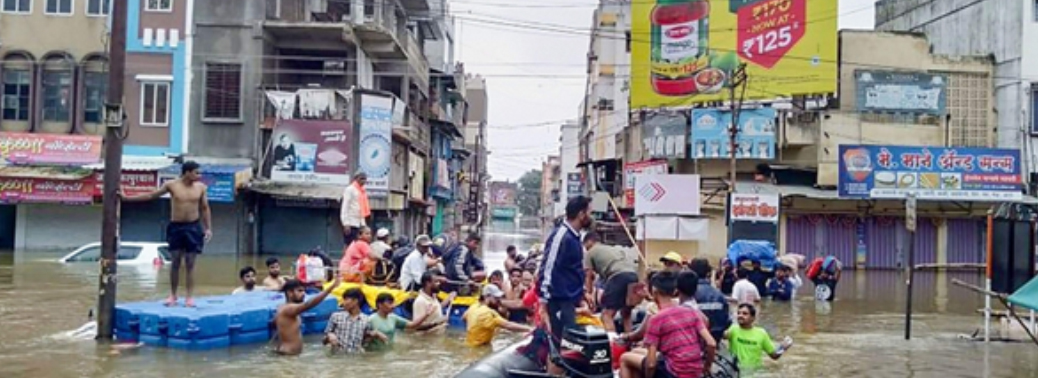FLOODS IN MAHARASHTRA
11, Aug 2019

Prelims level : Environment- Disaster Management, Geography of India
Mains level : GS-III- Disaster and disaster management.
GS-I- geographical features and their location - changes in critical geographical features (including waterbodies and ice-caps) and in flora and fauna and the effects of such changes
GS-I- geographical features and their location - changes in critical geographical features (including waterbodies and ice-caps) and in flora and fauna and the effects of such changes
- Context: Between August 1 and 10, rains battered south-western Maharashtra, and rising water levels in local rivers breached the banks. Areas in Pune, Kolhapur, Satara and Sangli saw large areas flooded, houses and roads damaged and lakhs of people displaced.
Background:
- Similar situation happened in the year 2005.
- Krishna river, the lifeline of South-Western Maharashtra, has wreaked havoc in the districts it flows through.
- Large tracts of land in Satara, Sangli, Kolhapur and Pune continue to remain under water.
Dams on Krishna:
- Dams dot the course of Krishna and her tributaries across Maharashtra, Karnataka, Andhra Pradesh and Telangana.
- These dams are the lifeline of western Maharashtra, and are a major supporting factor for the area’s sugarcane-based economy.
- Almatti, a major dam on Krishna that is located in Karnataka, close to the Maharashtra border, controls the flow of water into the neighbouring state. The release of water into the river and its tributaries are kept in check to conserve water.
The Effect of the Flood:
- As water levels rose after the heavy rainfall, almost all the dams started discharging water.
- What went wrong in the process was perhaps the lack of coordination between the Maharashtra and Karnataka governments to enable simultaneous discharge from Almatti dam.
- Almatti Dam
- The position of Almatti dam is unique, as this is the first dam on Krishna river after it leaves Maharashtra.
- The amount released from the dam is important to prevent any flooding upstream of Krishna, which is Maharashtra.
- In this case, the discharge from the dam was low, though the Maharashtra side had seen the river swelling due to heavy rain and opening of all dam gates.
- As the amount of water released from Almatti was kept low, the water of Krishna kept coming back, which led to the flooding.
- Chief Minister of Maharashtra intervention led to the increased discharge from Almatti. As of now, the discharge from this dam is over 5.3 lakh cusec as against the inflow of 6 lakh cusec.
What led to the flooding?
Concern by advocacy group SANDRP (South Asia Network of Rivers Dams and People)
- Why authorities didn’t release water from the dams in a controlled manner earlier.
- Controlled release of water would have allowed the dams enough reservoir space to withstand the heavy rain.
- It would have been a more effective measure compared to the kneejerk response of opening the dam gates to release large quantity of water.
Poor Dam Management:
- Water levels in the dam, as reported by the water resources department, had shown a steady rise since the beginning of monsoon.While the monsoon was sluggish in June, it picked up pace in July, and water levels in the dams rose.On July 10, the water level of all 726 dams in Pune Division stood at 23.25 per cent as against 34.63 per cent of last year.
- But by August 3, as the state witnessed intense spells of rain, these dams reported 69.9 per cent water storage.
- However, what might have brought about the urgency in discharge is the fact that the reluctance of the irrigation department to carry out release from the dams left little or no space in the reservoirs once the upstream areas started receiving torrential rains.
- With barely any other option, the dam gates were opened suddenly, and the catchment areas were flooded.
How Dam Management Works?
- Dam management is an inter-departmental job, which involves close coordination between the departments of revenue, water resources and agriculture, as well as the weather forecaster.The release of water is managed by taking into account the projected water usage for human consumption, agriculture and industries.
- In case of a weak monsoon, less water is released to tide over the non-monsoon months.
- One of the reasons why dam levels were allowed to reach up to 70 per cent might be because of the uncertainty of monsoon rains.
- In June and July, Pune Division reported cumulative rainfall of 522.1 mm, which was 105.1 per cent of the long-time average of 496.6 mm.
- But by August 10, the division recorded 309.1 mm as against the 69.9 mm normal, a startling 442.2 per cent more.
No Lessons from the past?
- In fact, Maharashtra had set up a committee after the Aug 2005 floods, but the report of that committee remains a state secret till date!
- We need to understand and acknowledge that capacity of our catchment areas to hold, to absorb, store the rainwater and recharge the groundwater in a decentralised manner is reducing, thanks to our indiscriminate and mindless development pursuits.
What needs to be done?
- We need to really work to improve the capacity of the catchment to hold, store and absorb the rainwater and recharge the groundwater.This includes increasing the capacity of our soils to hold and store moisture and having sufficient local water harvesting systems, wetlands, forests and other groundwater recharging mechanisms.
- That would help reduce the flood peaks and also drought frequency and intensity.
Conclusion:
- However, immediately, we need to ensure that the water stored in the dams is judiciously released to make way for possibly high rainfall incidents in coming weeks.
- The mismanagement of all the dams need to be put out in public domain and accountability fixed when the rule curves are violated.






